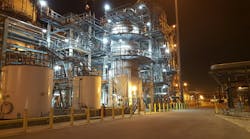How would you like to seriously reduce maintenance costs, production interruptions, and inventory costs without a capital project? You may be wondering how that could be done. The answer is you can accomplish those goals, and more, with a series of easy retrofit upgrades from legacy lighting to LED. And you don’t need to run new branch circuits; in many cases, such an upgrade can be done even while using parts of existing light fixtures.
Before we talk about how, let’s look closer at the why. People often look to LED for the energy savings, but other reasons for switching from a legacy technology to LED may be more important to you.
Relamping relief
Your legacy lamps may last for only 6,000 hours of operation, while LED will take you ten times further. With legacy lighting, you need a relamping program so aging lamps are replaced before their light output drops off to an unacceptable and dangerous level.
The timing of this is well-known for each kind of lamp; many spec sheets include a graph of light output over hours of service. You don’t want to reach the light output drop-off point where the line suddenly curves downward. So you replace functioning lamps before they get to that point.
In a typical relamping scenario, maintenance coordinates downtime with production to allow a relamping contractor access to the lights that are over production equipment or in an area where access means shutdown.
Typically, lifting platforms (often scissor lifts) are required to reach overhead lights. Temporary equipment moves may be required to get scissor lifts close enough horizontally to reach the fixture, unless a boom crane can do the job.
The contractor must get security clearance, and in many facilities an in-house person must keep tabs on the contractor’s crew. And unless this contractor follows all the rules for disposal and can haul away your old lamps, you’ll probably need a recycling contractor too.
Let’s say you have metal halide lighting. You play this game every other year and you never win. It’s just another chore for you and another cost for your company.
What if you could forget about relamping for the next 60,000 hours of operation? And eliminate future recycling costs? Since LED uses solid state lamp drivers instead of lighting ballasts, the ballast replacement ritual also becomes a thing of the past. How much did ballast replacement cost you last year, in labor hours, replacement parts, and lost production?
You also reduce the production interruptions that relamping brings, especially if yours is a multi-shift facility. You literally reduce red tape by 90%, because those work areas can be roped off every 60,000 hours of operation instead of every 6,000.
With those savings, your total cost of ownership (TCO) drops dramatically. You don’t need the motivation of energy savings to find the retrofit financially compelling. Strong as it is, the financial motivation may take a back seat to something even more motivating. We’ll discuss that next.
Better lighting
Continuing with our metal halide example, those “fast strike” lamps you paid extra for make a difference when recovering from a power loss. But the light isn’t truly instant on, it’s more like “instant dim” and then you wait for the lamp to reach full brightness. That usually means an annoying wait until work can resume. By contrast, LED really is “instant on”. You don’t need to wait for dim lights to regain their rated output.
True instant on is one of several advantages LED has over legacy lighting. With LED, you also get:
- Better color rendering.
- Brighter light without the temperature (Tcode) problems.
- Better light distribution
- Reduced glare.
- Correct beam width to fit your application.
- Light intensity that is consistent throughout the beam.
The light characteristics differ, depending upon the design of one particular LED luminaire versus another. So if you don’t have the right light with one LED design, try another. A responsive manufacturer can help you try different optic designs or even different fixtures to change the way the light throws or to change any other attribute.
With some experimentation, you’ll probably reduce or eliminate both shadows and task lighting. In many applications, LED technology makes it possible to eliminate shadows without moving or adding lights. You can improve visual acuity and worker safety, thereby enhancing productivity without trying to fit new raceway around process piping or other obstacles.
You may have some free infrastructure benefits, too. Even if you increase the light levels dramatically, the ultra-high efficiency of LED means less load on your branch circuits. And a reduction in load current provides the ability to expand the number of fixtures on an existing circuit.
Project size
The benefits of an LED retrofit are compelling. But how big of a project must this be?
The traditional comprehensive lighting project has many benefits. For example, you can change the lighting layout to improve how well things are lit up. A new arrangement may eliminate the shadows that currently exist, and that’s a key reason for proceeding with a layout change. Yet, there are always unknowns and the new layout may present new shadows.
And, this approach means running new branch circuits. That is often a deal killer for many kinds of applications; hazardous locations and harsh environments are two examples. Any building that has a densely-packed infrastructure of process piping is another.
A big lighting project also requires a capital request and perhaps significant downtime for the work to be done.
The good news is you can get those LED benefits without committing to a big lighting project. And in many cases, you can eliminate shadows without increasing the number of fixtures over what you already have.
The solution involves an easy retrofit against your legacy lighting. For some types of legacy lighting, you can quickly and easily change the fixture with no new wiring involved. For others, you leave the mounting hood in place and just replace the ballast body and lamp with a new driver housing. Direct replacements exist for most legacy ballast/lamp systems, and adapters are available for when there’s not a direct replacement. No new wiring, no new raceway, no moving fixtures around.
Getting started
You can do a few retrofits at a time, using your maintenance budget or perhaps the plant’s project budget instead of a capital request. If you want to go small scale (instead of a full-bore lighting project), where do you start?
Your lighting pain points are probably obvious. So start with those; spend a few minutes making a list of the worst offenders. Then visit some of those trouble spots. Note the location, lighting problem, and type and size of existing light source, and supply panel location.
Next, pick one trouble spot to work on. Do you need more lumens? Better color rendering? A wider beam? More consistent light? All of the above? Contact a lighting products manufacturer to see what the product solution(s) may be for the needs you identified.
You may need to try a few different luminaires to find the solution you were looking for. Because the installation is easy, so is the experimentation to see what works best in that location. If you have lighting problems similar to those at this first trouble spot, you’ll be doing a small “try before buy” experiment on what works for all of them.
When choosing the product you’re going to try, look for globes that are interchangeable, field replaceable, and relatively low weight. Your options should include versatile mounting hoods, retrofit adapters, and color temperature options. You should be able to find a true one-to-one retrofit solution, even with mounting height and application challenges.
Also evaluate the LED luminaires under consideration to ensure they have adequate surge protection. Today’s standard is 6kV for industrial applications.
As you repeat the process for each of the problems on your list, you’ll be gaining experience in how to fix your lighting problems. As those retrofits accumulate and lighting continues to improve, you’ll see brighter days ahead at your facility.
Sponsored by:



